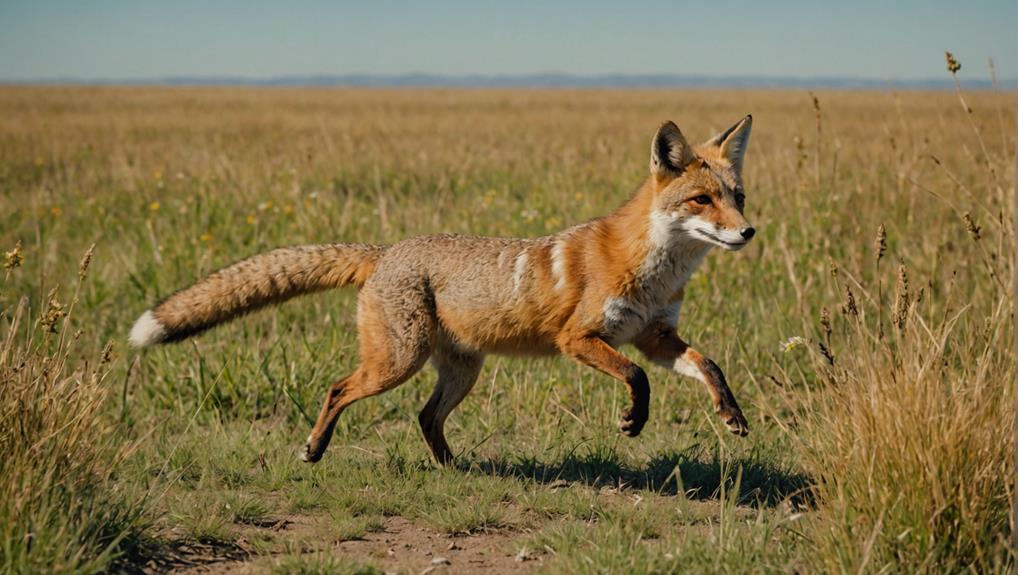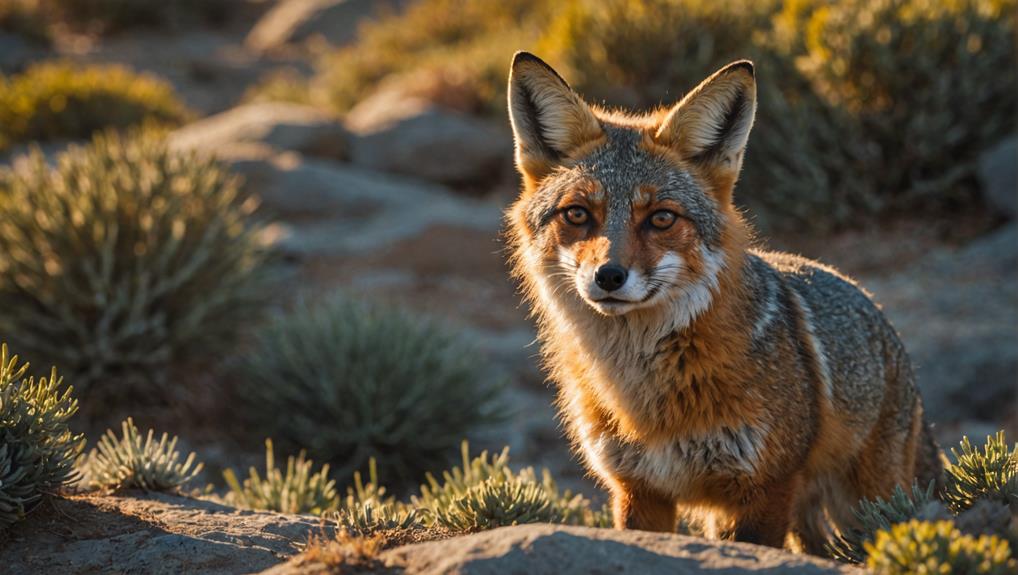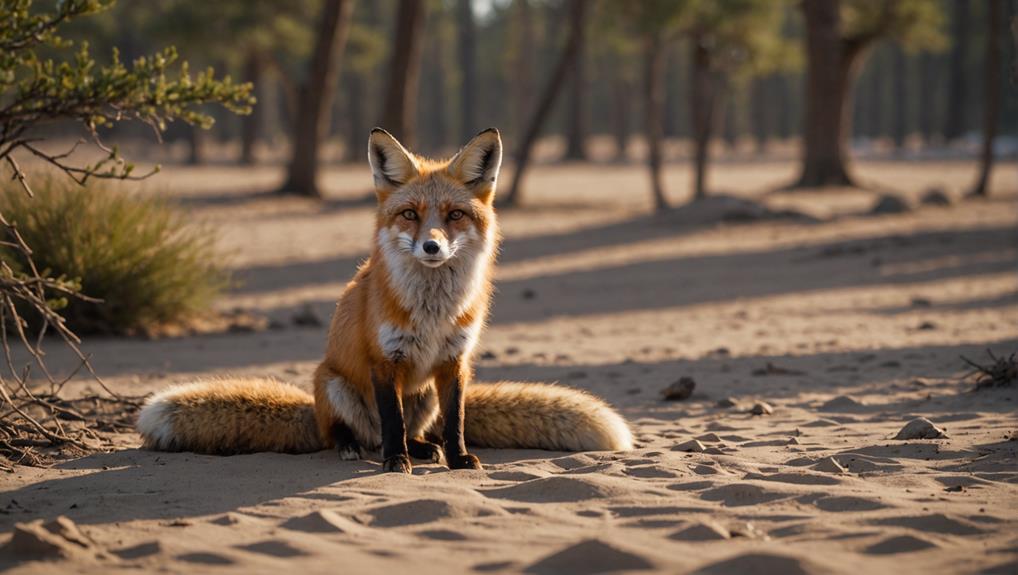If you're curious about North America's fox species, you're in for a treat! You'll find the clever Red Fox adapting to all sorts of habitats, while the adventurous Gray Fox takes to the trees. The Arctic Fox is like a fluffy snowball, perfectly suited for chilly tundras, and the Kit Fox showcases charm in desert heat. Don't forget the speedy Swift Fox, racing across prairies like it's in a competition! Last but not least, the Island Fox, a unique Californian, has a small but mighty presence. Each species has its quirks, and there's so much more to discover about them!
Contents
Overview of Fox Species
North America boasts four primary fox species, each uniquely adapted to their environments. The Red Fox, the largest of the true foxes, tips the scales at 8-14 pounds and thrives in diverse habitats, including urban areas where it often forages near human settlements. With its bushy tail and cunning nature, it's a familiar sight in fields and urban areas alike.
Then there's the Gray Fox, a true acrobat! This clever fella can actually climb trees, making it quite the surprise in wooded habitats.
Now, let's not forget the Arctic Fox, a master of survival in the chilly tundra. Its insulated fur changes color with the seasons—white in winter for camouflage, brown in summer. Talk about a wardrobe change!
Finally, we've the Kit Fox, the smallest of the bunch, weighing in at just 4-6 pounds. This little guy thrives in desert and brushy areas, proving that size isn't everything.
Each of these North American foxes plays a vital role in their ecosystems, from the nimble Gray Fox to the resourceful Arctic Fox.
Red Fox: The Adaptable Canine
Among the fascinating fox species in North America, the Red Fox stands out as an incredibly adaptable canine. Weighing between 8 to 14 pounds, these clever creatures thrive in various habitats, even urban areas. With their striking reddish coats and black ears, you can't help but admire their beauty!
Here's a quick look at some of the Red Fox's unique traits:
| Feature | Details | Fun Fact |
|---|---|---|
| Weight | 8 to 14 pounds | Largest member of true foxes! |
| Reproduction | 4 to 7 kits per litter | Kits receive lots of care! |
| Hunting Techniques | Exceptional hearing, magnetic orientation | They can hunt with style! |
| Social Behavior | Highly social, vocal communication | Their screams are quite entertaining! |
These social animals are known for their territorial instincts and the way they communicate with one another. They use various vocalizations, from playful barks to urgent mating calls. Their incredible hunting techniques allow them to capture small mammals with ease, making them quite the skilled predators. Whether you're in a city or the countryside, the adaptable Red Fox continues to capture our hearts!
Gray Fox: The Tree Climber

When you think of foxes, you might picture them running through fields, but the Gray Fox takes things to a whole new level—literally!
With its impressive climbing skills, this clever creature can dart up trees to escape danger or find a tasty snack.
Living in wooded areas, the Gray Fox has adapted perfectly to its environment, proving that it's not just another pretty face in the fox family!
Unique Climbing Abilities
Though many canids prefer to stay grounded, the gray fox (*Urocyon cinereoargenteus*) stands out with its remarkable climbing skills. Unlike other members of the canid family, gray foxes possess semi-retractable claws that give them an edge when it comes to climbing. These adaptations allow them to thrive in diverse environments, including urban settings where they may encounter urban foxes' adaptability while foraging for food.
Imagine a furry acrobat, skillfully navigating tree branches to scout for dinner or stay safe from predators. Their unique climbing abilities set them apart from their relatives, allowing them to thrive in various habitats, even urban areas. You might catch a glimpse of a gray fox perched on a branch, keeping a watchful eye on its surroundings. It's as if they're saying, "I see you, but you can't see me!"
These agile creatures climb to access food sources like birds and fruits, showcasing their cleverness. Their adaptability not only helps them survive but also makes them fascinating to observe. Picture a gray fox dashing up a tree, blending playfulness with resourcefulness.
Adaptations to Woodland Habitats
Gray foxes aren't just skilled climbers; they're also perfectly adapted to thrive in woodland habitats. With their unique tree-climbing abilities, Gray foxes navigate their leafy homes with ease. This talent is essential for evading predators and finding food in their natural habitat, especially in mixed landscapes where prey is abundant habitat diversity and preferences.
Let's dive into some of the cool adaptations that make these nocturnal species so fascinating:
- Semi-retractable claws: Perfect for gripping branches!
- Flexible ankle joints: They can twist and turn as they climb.
- Thick fur coat: A mix of gray, black, and reddish hues for great camouflage.
- Excellent night vision: Helps them navigate and hunt under the stars.
- Diverse diet: They munch on small mammals, birds, and fruits, often raiding nests high up in the trees.
These adaptations not only make Gray foxes skilled climbers but also enhance their stealth and survival.
Arctic Fox: The Tundra Dweller
When you think of the Arctic fox, picture a furry little survivor thriving in the chilly tundra.
With its thick coat that changes color with the seasons, this clever creature has some serious tricks up its sleeve to stay warm and camouflaged.
Plus, its diet isn't just about lemmings; it's like a furry scavenger on a mission, ready to feast on whatever's left behind!
Physical Adaptations for Survival
The Arctic fox is a remarkable survivor in the harsh tundra, boasting a range of physical adaptations that ensure its resilience against extreme cold.
Unlike the red fox, the Arctic fox sports a rounded body shape that helps it retain heat. You'd be amazed to learn how its thick, warm fur coat insulates against frigid temperatures and changes color for camouflage—turning white in winter and brown in summer.
Here are some key adaptations that make this fox thrive:
- Insulating Fur: Thick fur keeps them warm, even in biting winds.
- Round Body Shape: This compact form minimizes heat loss.
- Fluffy Tail: Not only does it provide warmth, but it also helps them communicate with other foxes.
- Exceptional Hearing: Their hearing range goes from 125 Hz to 16 kHz, making them keen hunters.
- Food Hoarding: They can store fat reserves and stash food to survive lean times.
With these adaptations, the Arctic fox population remains strong, showcasing nature's ingenuity in the face of adversity.
Isn't it fascinating how life finds a way?
Diet and Feeding Habits
Arctic foxes have a diverse diet that adapts to their harsh environment, primarily relying on small mammals like lemmings and voles during the summer months.
These clever little foxes prefer to feast on whatever's in season. When lemmings are plentiful, they can munch through dozens in a day! But don't be fooled; they're generalist omnivores, so they also enjoy birds, fish, and even carrion.
In the frigid Arctic tundra, scavenging behavior plays a big role in their feeding habits. You might catch them noshing on leftovers from larger predators, which helps them make the most of limited food resources.
Energy conservation is crucial for survival here, so Arctic foxes store fat and stash food away for tough times. Imagine having a little pantry stocked with snacks for winter!
Swift Fox: The Prairie Sprinter

Swift Foxes are fascinating little creatures that embody the spirit of the North American grasslands. Weighing in at just 4-6 pounds and standing about 12 inches tall, their small size makes them one of the tiniest fox species around.
But don't let their size fool you; these little sprinters can reach speeds of up to 30 miles per hour! They're adapted to thrive in the prairies, where they often use burrows for shelter.
Here are a few highlights about the swift fox:
- Diverse Diet: They munch on small mammals, insects, fruits, and even carrion.
- Nocturnal Lifestyle: You'll most likely spot them at night, keeping their activities under the radar.
- Burrowing Experts: They often take over abandoned prairie dog burrows or dig their own.
- Critical Habitat: Sadly, habitat loss is a significant threat to their survival.
- Conservation Efforts: Many initiatives are underway to protect these speedy little critters.
These charming foxes remind us of the importance of preserving their habitats so we can continue to enjoy the beauty of nature.
Who knew such a small creature could pack such a punch?
Kit Fox: The Desert Survivor
In the heart of North America's arid landscapes, you'll find the Kit Fox, a remarkable survivor perfectly adapted to desert life. As the smallest fox species, weighing only 4 to 6 pounds and standing about 12 inches tall at the shoulder, it's hard not to admire this little dynamo.
You might notice its large ears, which aren't just for show—they help the kit fox dissipate heat and tune into the sounds of the desert.
These clever creatures are nocturnal, spending their days tucked away in burrows, escaping the scorching sun.
When night falls, they come alive, hunting for their favorite foods. Their diet is primarily insectivorous, but they also enjoy the occasional small mammal or fruit, proving they're opportunistic foragers always on the lookout for a tasty snack.
Socially monogamous, Kit Foxes often form long-term pair bonds, working together to raise their young.
Isn't that sweet? Watching them care for their little ones showcases the beauty of teamwork in nature.
Island Fox: The Unique Californian

While the Kit Fox thrives in the deserts of the Southwest, the Island Fox offers a unique glimpse into how evolution shapes species in isolated environments.
This small fox, found only on California's Channel Islands, isn't just cute but also critically endangered. Sadly, habitat loss and the introduction of non-native species have taken a toll on their population.
Thankfully, conservation efforts have made a difference, boosting numbers from around 100 in the early 2000s to about 1,800 by 2020.
Here are some interesting facts about the Island Fox:
- They're one of the smallest fox species in North America.
- Their diet as omnivores includes small mammals, birds, insects, and fruits.
- They've a longer body and shorter legs, helping them adapt to their environment.
- Their coat varies from grayish to light brown, making them masters of camouflage.
- They play a vital ecological role by controlling rodent populations, which keeps the island ecosystems healthy.
Isn't it fascinating how these little foxes thrive? Their remarkable adaptability is a testament to nature's wonders, reminding us of our role in protecting such unique species.
Conserving Fox Habitats
To protect fox species across North America, conserving their habitats is essential. Habitat loss is a real threat to these clever creatures, and we need to rally together for effective conservation efforts. Urbanization has turned once-vibrant landscapes into concrete jungles, making it tough for fox populations to thrive.
Luckily, communities are stepping up! Habitat restoration initiatives aim to combat the impacts of urban sprawl and climate change. These local projects not only benefit foxes but also foster a sense of unity and teamwork among neighbors.
Plus, legal protections are crucial—they help curb poaching and protect natural habitats. It's like giving foxes a legal shield!
Education initiatives play a pivotal role too. By raising public awareness about the importance of foxes, we encourage everyone to get involved. Imagine teaching kids about the adorable Arctic fox while inspiring them to participate in wildlife conservation!
Final Thoughts
In conclusion, North America's fox species are truly remarkable, each with their own unique traits and habitats. From the clever red fox to the adorable island fox, they all play vital roles in their ecosystems. Let's appreciate these fascinating creatures and work together to protect their homes. After all, every little effort counts! So, whether you spot a fox in your backyard or on a hike, take a moment to enjoy their beauty and quirks.














